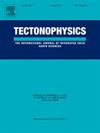Analysis of seismic reflection data from the Northern Hispaniola margin: Implications for the recent evolution of the Northern Caribbean Plate boundary
IF 2.6
3区 地球科学
Q2 GEOCHEMISTRY & GEOPHYSICS
引用次数: 0
Abstract
The northern margin of Hispaniola features an accretionary prism with morphological structures shaped by tectonic, hydrodynamic and sedimentary processes in oblique convergence between North American and Caribbean plates. The HAITISIS data in the northern Caribbean plate boundary elucidate the relationships between fault-driven tectonic activity, seafloor morphology, and effects of transpressional deformation. We evidence an E-W-trending spatial variation in deformation accommodation and sedimentary records along the accretionary prism. The distinct morpho-structural character of the seafloor and sedimentation patterns originated during the Upper Miocene-Pliocene tectonic reorganization of the northern Caribbean Plate boundary, which is associated with the onset of the oblique collision of the Caribbean and North American Plates carrying Hispaniola to the transpressive plate boundary opposite the Bahamas Carbonate Platform. An accretionary prism is formed, and segments of the eastern strand of the Septentrional-Oriente Fault Zone (SOFZ) are activated, resulting in lateral sediment source displacements, influencing sedimentary infill and deformation patterns.
A mass transport deposit (MTD) in the Eastern domain caused differential compaction and remobilization of recent seismic units and has affected the seafloor morphology. The MTD is absent in the Western domain, and canyons are found in the Eastern domain.
The early Miocene SOFZ onset and evolution is not a continuous eastward propagation. Lateral displacements of canyons provide a chronology for strike-slip and thrust faults before the SOFZ initiation and the formation of the current fault segments. The variations in fault density, cumulative displacement along strike-slip faults, morphology of Northern Hispaniola insular slope (including width and tectonic style), and tilting of basin surfaces suggest the underthrusting of the North American plate beneath the Caribbean plate has ceased at the transition between the Eastern and Western domains. This may be attributed to westward rheological transition of North American plate's crust (from oceanic to continental) at the level of the Bahamas platform.
伊斯帕尼奥拉北部边缘的地震反射数据分析:对北加勒比板块边界近期演化的启示
伊斯帕尼奥拉岛北缘在北美和加勒比板块的斜辐合中具有构造、水动力和沉积作用形成的增生棱柱状地貌结构。北加勒比海板块边界的海地资料阐明了断层驱动的构造活动、海底形态和跨震变形效应之间的关系。我们发现沿增生棱柱的变形容纳和沉积记录具有东西向的空间变化。其独特的海底形态构造特征和沉积模式起源于上中新世-上新世加勒比海板块边界构造重组时期,这与加勒比海板块与北美板块斜向碰撞的开始有关,将伊斯帕尼奥拉岛带到了与巴哈马碳酸盐岩地台相对的跨陆板块边界。形成了一个增生棱镜,并激活了七东断裂带东段,导致沉积物源侧向位移,影响了沉积充填和变形模式。东部地区的块体搬运沉积(MTD)引起了近期地震单元的压实差异和再活化,并影响了海底形态。西域中没有MTD,东域中有峡谷。早中新世SOFZ的发生和演化不是一个连续的向东传播过程。在SOFZ形成和现今断段形成之前,峡谷的横向位移为走滑和逆冲断层提供了年代学。断层密度的变化、沿走滑断层的累积位移、北伊斯帕尼奥拉岛斜坡的形态(包括宽度和构造样式)以及盆地表面的倾斜表明,北美板块在加勒比海板块下的逆冲在东西域的过渡阶段已经停止。这可能归因于北美板块地壳在巴哈马地台水平的西向流变转变(从海洋到大陆)。
本文章由计算机程序翻译,如有差异,请以英文原文为准。
求助全文
约1分钟内获得全文
求助全文
来源期刊

Tectonophysics
地学-地球化学与地球物理
CiteScore
4.90
自引率
6.90%
发文量
300
审稿时长
6 months
期刊介绍:
The prime focus of Tectonophysics will be high-impact original research and reviews in the fields of kinematics, structure, composition, and dynamics of the solid arth at all scales. Tectonophysics particularly encourages submission of papers based on the integration of a multitude of geophysical, geological, geochemical, geodynamic, and geotectonic methods
 求助内容:
求助内容: 应助结果提醒方式:
应助结果提醒方式:


